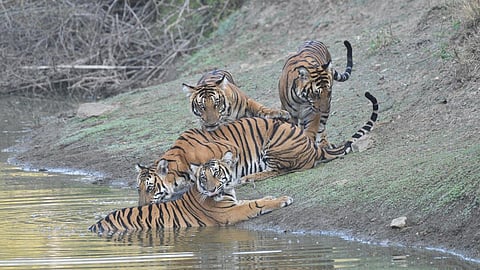

MYSURU: With the rising mercury level and dried up streams and ponds in the Nagarhole national park, efforts are made to fill up waterholes with tankers to quench the thirst of wild animals.
The Nagarhole national park has over 200 tanks in Dammanakatte and Veeranahosahalli forest ranges of which around 80 per cent of the small water bodies are dried up forcing the wild animals to move out of the forest in search of water.
This has added to the worry of the forest personnel keeping a vigil on forest fire. They are now taking measures to fill the tanks.
Though the forest department has sunk borewells and electrified them using solar power inside the forest, it is not enough to meet the demand for water. They have pressed more than half a dozen tankers to fill the ponds inside the forest which has a high density of wild animals including elephants, tigers, bison, sambar, deers among others.
As the Dammanakatte and Veeranahosahalli range has no river, they have to depend on storage of rainwater which is not sufficient during the peak summer between March and May.
The department had come out with an action plan to desilt the tanks and install solar borewells to fill major tanks to help quench thirst of animals.
Siddu, a Safari vehicle driver, said tigers are sighted everyday in Safari near waterholes. He said sighting of wild animals that has gone viral on various platforms has made people make beeline for Safari.
The forest guards are trying to fill up the waterholes on priority as scarcity of water would lead to spike in man-animal conflict incidents.
Nagarhole DCF Seema said a majority of the ponds either have very less water or dried up in both the ranges of the national park. She said they will rope in more tankers to fill ponds so that the wildlife don’t suffer.
She said the tourist zone in Dammanakatte has more dried up tanks and felt that this is also reason for sighting of animals near the waterholes.
She hoped that pre-monsoon showers will improve the situation in the national park. Meanwhile, forest officials maintained that there was no case of animal death due to water scarcity like in 2015-16.